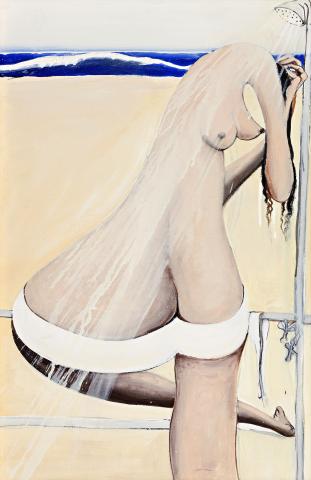WASHING THE SALT OFF III, 1985
BRETT WHITELEY
oil on canvas on composition board
92.0 x 61.0 cm
signed, dated and inscribed with title verso: Brett Whiteley / “Washing the salt off 3” / 1985
Estate of Brett Whiteley, Sydney
Thence by descent
Estate of Arkie Whiteley, Sydney
Private collection, Sydney
Washing the Salt Off I, 1985, oil on canvas, 167.0 x 152.0 cm, private collection
Washing the Salt Off II, 1984, oil on canvas, 86.5 x 86.5 cm, private collection
I know that in my work there is a certain sensuality, sexuality. There is a certain addiction to the curve and to the carnal, to the rounded, I mean even to lust, almost. I see sensuality, sexuality everywhere: in clouds, in mountains, in fruit, and seemingly most of human motivation is caused by it.'1
For Whiteley, a deep appreciation for the sensuality of the human form permeated every aspect of his life and art. Recognised by art critic Bryan Robertson during Whiteley’s early years in London as ‘a level of sexual and sensual sophistication rare in an artist so young’,2 indeed this predisposition would ultimately underpin and inspire his entire creative oeuvre – from his idyllic pastorals and sumptuous Lavender Bay interiors, to more turbulent, politically-charged works such as American Dream 1968 – 69 and Alchemy 1972 – 73. Without doubt however, it is in the myriad of paintings, drawings, sculptures and etchings dedicated to the female nude that Whiteley most thoroughly and adeptly manifests his enduring preoccupation with the sensual and tactile – exploiting the expressive and abstract possibilities of the genre to create some of the most erotic nudes ever conceived by an Australian artist. Clearly, Whiteley too considered the subject ‘predominant really…a very major part of my work’,3 elaborating thus ‘…If genius is the atheist’s word for God… then the attempt to visualise the great nude would be the highest point of creation, for perfection is impossible, and no distortion can be extreme enough.’4
Plagued by fears of stagnation, during the early 1960s Whiteley shifted away from the abstractions that had brought him such widespread acclaim to embark upon his first consolidated depictions of the female nude in the ‘Bathroom series.’ A celebration of love and sensuality extolling his new wife and muse Wendy, the series was influenced by the ablutionary scenes of artists such as Bonnard and Degas (which Whiteley had viewed in the Tate Gallery, London) and heralded the young artist’s breakthrough as an accomplished figure draughtsman. More importantly perhaps, these early Bathroom pictures signified a desire to make eroticism more explicit in his art; as Whiteley himself elucidated in the catalogue accompanying the group exhibition ‘New Generation 1964’ at Whitechapel Gallery, ‘…all the paintings I have made in the last four years have been concerned one way or another with sex and the desire to record sensual behaviour.’6 Upon his return to Australia over the summer of 1965-66, Whiteley’s predilection for the erotic blossomed in his ‘Beach series’ which immortalised the curvaceous, languid forms of sun-tanned bathers indulging in all the pleasures the country’s beach culture had to offer. Highly sybaritic in tone, these works established Whiteley as ‘the great Australian painter of female sexuality at the beach’6 and notably paved the way for the artist’s more refined treatment of the theme two decades later in compositions such as the present.
An iconic work, Washing the Salt Off III, 1985 captures the sexual revolution sweeping Australia at the time, featuring a topless bather arching gracefully away from the viewer with her backside unapologetically exposed as she teeters on one foot to wash sand off the other. Paying homage to the nation’s quintessential beach culture, the composition is, however, noticeably bereft of the mixed-media Pop Art emblems – beer cans, plastic ice cream cones, Bex boxes etc - which had punctuated the artist’s earlier interpretations. Rather, with the bather magnified so that she almost impinges out of the frame, the focus here is unequivocally Whiteley’s sheer delight in the beauty of the female form – voluptuous, fecund and overtly sexual, yet at the same time tender and softly-toned. Infused with an unmistakable sense of voyeurism, indeed the composition is a magnificent example of not only the artist’s prodigious talent as a draughtsman, but his lifelong quest to visualise the ‘perfect’ nude; as Whiteley himself wrote with characteristic irreverence in catalogue notes accompanying an exhibition of recent nudes in 1981,
‘…most men, and certainly all artists, even if many never get around to actually painting it, carry in their heads the great nude. The Venus, the Bathsheba, the Bather, Diana, even the great centrefold, he carries all his life the idealisation, carries it like some little uncut gem in his mind, waiting there to be given form. Filtering down through civilisation is the urge to show this glimpse of beauty, where invention and skin become one, and the history of art marries the whole history of one’s sex. Mistress, mother, lover, whore, obtainable – unobtainable, it is the wonder of a perfect distortion.’7
1. Whiteley, B., cited in Don Featherstone's film Difficult Pleasure: A Portrait of Brett Whiteley, 1989
2. Robertson, B., cited in McKenzie, J., ‘Obituary: Brett Whiteley’, ‘Divided Self, Sweeping Line’, The Guardian, London,18 June 1992, n.p.
3. Whiteley, B., op. cit.
4. Whiteley, B., ‘Recent Nudes’, exhibition catalogue, Artist’s Studio, Circular Quay,1981, n.p.
5. Whiteley cited in Robertson, B., The New Generation: 1964, Whitechapel Gallery, London, 1964, n.p.
6. Don Featherstone, The Beach: Beach Culture in Australia, 2000 (film)
7. Whiteley, B., 1981, op. cit.
VERONICA ANGELATOS
